
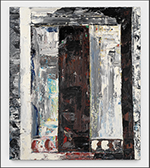

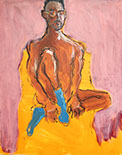
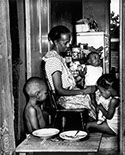
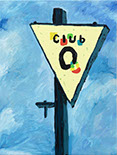
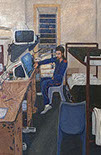
“Hide And Seek”
New Work by Jeanne Bieri at Detroit Contemporary
July 1–July 30, 2023
by K.A. Lett
Jeanne Bieri’s deeply personal fiber works, collaged from vintage quilt fragments and U.S. army blankets collected from 20th century conflicts, were on view throughout July in her solo show “Hide and Seek” at Detroit Contemporary. The exhibition functions as a mini-retrospective—reflecting the artist’s output over the last ten years. Overlaid with elaborate hand embroidery, they represent a “stitching together” of Midwestern lives and stories into a rich visual narrative of resilience and reclamation.
Bieri, who was awarded a Kresge Fellowship for Fine Art in 2017, has been a frequent prize winner for her fiber work, including the Detroit Scarab Club’s Gold Medal in 2008, 2011 and 2014, as well as a Michigan Council for the Arts grant in 2000 for the study of historic regional quilts.
Discovering fine art in her thirties after moving to Detroit, Bieri brought a trove of memories from her western Michigan childhood to her newfound passion—memories that provide the heart of this emotionally resonant and visually rich body of work. Her father, who fought in World War II, returned with stories of devastation in postwar France, along with his well-worn army blankets. Her female relatives contributed an attitude of frugal make-and-mend, as well as a keen appreciation for the decorative potential of traditional quilt making. And Bieri’s education in fine art at Wayne State University in the 1990s provided a sturdy conceptual scaffolding upon which to build a highly personal record of her life and the life of the community from which she came.
“I grew up on a farm in Hastings, Michigan, went to western Michigan University, taught in a two-room schoolhouse in Hopkins, Michigan, married, and moved to Detroit in 1972,” she states. “In the 80s, I discovered art and art making and it was as if a curtain opened, and I was able to translate the visual world into my terms.”
One of the early artworks in Bieri’s collection of tapestries, Mended, demonstrates the idiosyncratic process with which she combines unconventional materials in esthetically satisfying ways, all done by hand and intuitively. Along the right side of the roughly 48” x 65” tapestry, is a wide, irregular swath salvaged from the ruins of a vintage crazy quilt, banded in jagged crimson, and surrounded by what might be an olive-green landscape—map-like, almost—over which float meandering, stitched linear currents that resolve into concentric circles throughout the composition. Significantly, surgical suture silk salvaged from the Korean War is Bieri’s preferred embroidery thread—here, the act of decoration functions as a ritual of healing.
Bieri describes her creative process as meditative, as she coaxes the quilt and blanket stories to the surface. She states: “My stories become threaded into theirs, together into one. The chain stitching gives a sense of unity, a sturdiness, one I appreciate. The linear quality of the stitch defines the flatness of the surface and at the same time penetrates the fabrics, fusing the layers, fixed for all time.”
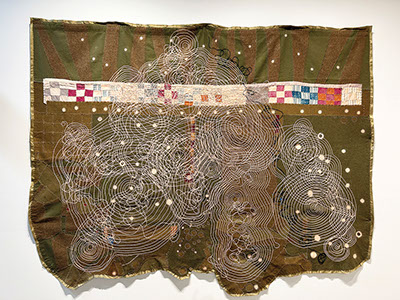
Shirt Quilt, 2017, approx. 75” wide x 64” high. Assorted army blankets, vintage cotton
patchwork quilt fragment, rayon, wool, silk, cotton, army suture silk embroidery,
repurposed dyed quilt lining. Photo K.A. Letts.
Shirt Quilt, created at about the same time as Mended, is a slightly more organized composition. The top quarter of the piece is a row of vertically radiating stripes in two shades of army blanket green. Beneath, a line of salvaged checked quilt piecing gives way to more irregularly assembled fabrics that imply a topographical map. The chain stitching in Shirt Quilt is more densely worked than in Mended and begins to imply a ghostly figure of some kind.
In more recent work, the overall contours of the pieces have begun to reference articles of clothing. The Dance, shown in 2022 at the Elaine L. Jacob Gallery, takes on the character of a figure festively stepping across the wall. The recognizable leaf shapes in silver lamé within the composition reflect a looser, more gestural iteration of her process.
Frog Quilt, a tapestry from 2023 that was shown for the first time in “Hide and Seek” at Detroit Contemporary, illustrates the continued evolution of her art practice—away from the conventional quilt format and toward a free-form overall shape dictated by the internal elements of the artwork. Recognizable cutout reverse appliqués of frogs and leaves circulate throughout the composition, interspersed with pieced circles and rows of stripes.
A group of small, monochrome paintings, based on vintage snapshots that Bieri has collected over the years at yard sales and thrift shops, share the wall with her fiber work. She does not know the subjects in the original photos but feels a need to care for these lost images. A number of the paintings, in particular, record a common sales practice of itinerant photographers in the 1950s, who would lead a pony around a suburban neighborhood to attract customers. Doting parents would commission a photo of their child on horseback along with a bonus pony ride.
Though the small paintings do not offer the lush and sensual pleasures of her tapestries, they represent another common through-line in her work. Bieri often acknowledges the value of humane care and her capacity for feeling the innate significance in ordinary lives, as well as for the shared experience that makes up a community. In both her fiber pieces and in these small pictures, Bieri honors the commonalities of our human species in all its quotidian particularity.
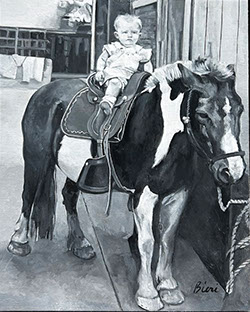
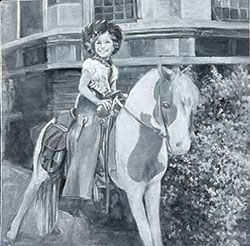
(Left) Buddy, 2023, 10 x 8 inches. Oil on canvas. (Right) Butterfly, 2023, 8 x 8 inches. Oil on canvas,
Photos: K.A. Letts
Bieri’s work not only conserves, but actively finds, new beauty from the historic resonance of discarded materials and images. Scraps and remnants from the lived histories of G. I.’s and farm wives in America’s heartland are combined in a poignant tapestry of memory. The dull greens and tans of army blankets from various conflicts, juxtaposed with shiny bright satins and meandering currents of embroidery, reveal a previously undiscovered, yet somehow familiar, country.
K.A. Letts is the Detroit editor of the New Art Examiner, a working artist (kalettsart.com) and art blogger (rustbeltarts.com). She has shown her paintings and drawings in galleries and museums in Toledo, Detroit, Chicago, and New York. She writes frequently about art in the Detroit area.
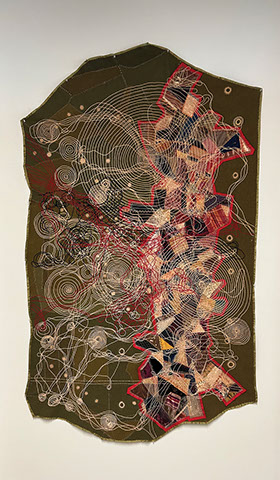
Mended, 2016, approx. 48” wide x 65” high. Assorted army blankets, vintage cotton patchwork quilt fragment, rayon, wool, silk, cotton, army suture silk embroidery, repurposed dyed quilt lining. Photo K.A. Letts.
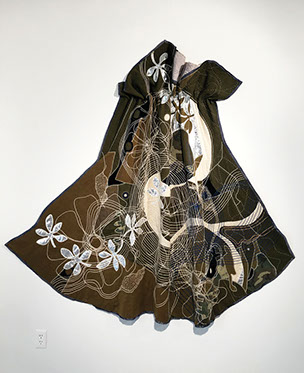
The Dance, 2022, approx. 8” (at top), 72”wide (at bottom) x 84” high. Army blankets silver lame applique, rayon, wool silk, cotton, army suture silk embroidery, repurposed dyed quilt lining. Photo K.A. Letts.
rgb.jpg?crc=3856098163)
Frog Quilt, 2023, approx. 60”wide x 96” high. Army blankets, salvaged, pieced vintage fabrics, repurposed dyed quilt lining. Photo K.A. Letts.